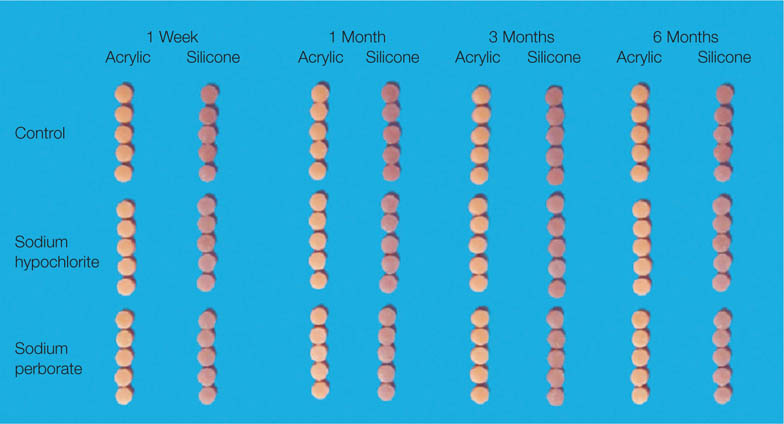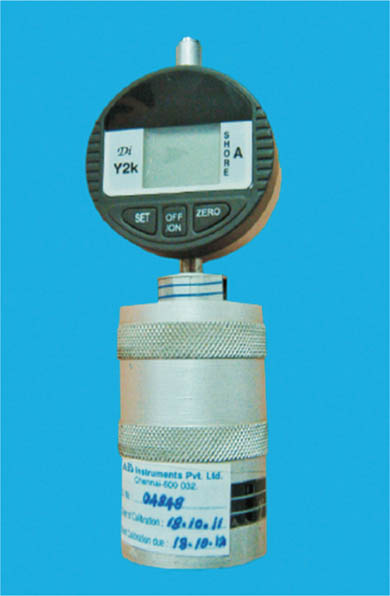J Adv Prosthodont.
2013 Aug;5(3):270-277. 10.4047/jap.2013.5.3.270.
Effect of denture cleansers on surface hardness of resilient denture liners at various time intervals- an in vitro study
- Affiliations
-
- 1Department of Prosthodontics, Post Graduation Student, Maharishi Markandeshwar University, Mullana, Ambala, India.
- 2Department of Prosthodontics, Faculty of Dentistry, Maharishi Markandeshwar University, Mullana, Ambala, India. drsgargmmu@gmail.com
- 3Department of Prosthodontics, Faculty of Dentistry, Bhojia Dental College, Himachal Pradesh University, Shimla, India.
- KMID: 2118166
- DOI: http://doi.org/10.4047/jap.2013.5.3.270
Abstract
- PURPOSE
This study was aimed to determine the effect of two chemically distinct denture cleansers and water on the surface hardness of acrylic and silicone based soft denture liners at various time intervals.
MATERIALS AND METHODS
Two commonly used commercial resilient liner material were selected based on their chemical composition (silicone- and acrylic-based soft liners) for this investigation. 120 cylindrical specimens were made of 15 mm x 10 mm dimensions (according to ASTM: D-2240-64T) in a custom made metal mold. All specimens were stored in artificial saliva throughout the study. Forty specimens were cleansed daily in 0.5% sodium hypochlorite solution; forty were cleansed in sodium perborate and remaining forty specimens were daily rinsed in water. Testing was done at 1 week, 1 month, 3 months and 6 months for surface hardness using a Shore A Durometer. A mean of 3 reading for each sample was subjected to one-way ANOVA, Post Hoc test and pair-t test for statistical analysis. P values of less than 0.05 were taken as statistically significant.
RESULTS
Surface hardness of all the samples was significantly higher after a period of 6 months irrespective of the cleansing treatment. Minor changes were observed between control, sodium hypochlorite and sodium perborate groups with time. Greater change was observed in surface hardness of acrylic-based soft denture liners as compared to silicone-based soft liners for all groups, as time progressed.
CONCLUSION
Silicone-based soft denture liners performed significantly better in all cleansing treatments than acrylic-based soft denture liners.
Keyword
MeSH Terms
Figure
Reference
-
1. Brożek R, Koczorowski R, Rogalewicz R, Voelkel A, Czarnecka B, Nicholson JW. Effect of denture cleansers on chemical and mechanical behavior of selected soft lining materials. Dent Mater. 2011; 27:281–290.2. Kasuga Y, Takahashi H, Akiba N, Minakuchi S, Matsushita N, Hishimoto M. Basic evaluation on physical properties of experimental fluorinated soft lining materials. Dent Mater J. 2011; 30:45–51.3. Dootz ER, Koran A, Craig RG. Physical property comparison of 11 soft denture lining materials as a function of accelerated aging. J Prosthet Dent. 1993; 69:114–119.4. Murata H, Chimori H, Hong G, Hamada T, Nikawa H. Compatibility of tissue conditioners and denture cleansers: influence on surface conditions. Dent Mater J. 2010; 29:446–453.5. Mese A, Guzel KG. Effect of storage duration on the hardness and tensile bond strength of silicone- and acrylic resin-based resilient denture liners to a processed denture base acrylic resin. J Prosthet Dent. 2008; 99:153–159.6. Machado AL, Breeding LC, Puckett AD. Effect of microwave disinfection on the hardness and adhesion of two resilient liners. J Prosthet Dent. 2005; 94:183–189.7. Mese A. Bond strength of soft denture liners following immersion of denture cleanser. Biotechnol Biotechnol Equip. 2006; 20:184–191.8. Garcia RM, Léon BT, Oliveira VB, Del Bel Cury AA. Effect of a denture cleanser on weight, surface roughness, and tensile bond strength of two resilient denture liners. J Prosthet Dent. 2003; 89:489–494.9. Budtz-Jørgensen E. Materials and methods for cleaning dentures. J Prosthet Dent. 1979; 42:619–623.10. Zarb GA, Bolender CL, Eckert S, Jacob R, Fenton A, Mericske-Stern R. Prosthodontic Treatment for Edentulous Patients: Complete Dentures and Implant-Supported Prostheses. 12th ed. Mosby;2003. p. 198–202.11. Leite VM, Pisani MX, Paranhos HF, Souza RF, Silva-Lovato CH. Effect of ageing and immersion in different beverages on properties of denture lining materials. J Appl Oral Sci. 2010; 18:372–378.12. El-Hadary A, Drummond JL. Comparative study of water sorption, solubility, and tensile bond strength of two soft lining materials. J Prosthet Dent. 2000; 83:356–361.13. Hermann C, Mesquita MF, Consani RL, Henriques GE. The effect of aging by thermal cycling and mechanical brushing on resilient denture liner hardness and roughness. J Prosthodont. 2008; 17:318–322.14. Saraç D, Saraç YS, Kurt M, Yüzbaşioğlu E. The effectiveness of denture cleansers on soft denture liners colored by food colorant solutions. J Prosthodont. 2007; 16:185–191.15. de Freitas Fernandes FS, Pereira-Cenci T, da Silva WJ, Filho AP, Straioto FG, Del Bel Cury AA. Efficacy of denture cleansers on Candida spp. biofilm formed on polyamide and polymethyl methacrylate resins. J Prosthet Dent. 2011; 105:51–58.16. Ferreira MA, Pereira-Cenci T, Rodrigues de Vasconcelos LM, Rodrigues-Garcia RC, Del Bel Cury AA. Efficacy of denture cleansers on denture liners contaminated with Candida species. Clin Oral Investig. 2009; 13:237–242.17. Goll G, Smith DE, Plein JB. The effect of denture cleansers on temporary soft liners. J Prosthet Dent. 1983; 50:466–472.18. Mante FK, Mante MO, Petropolous VC. In vitro changes in hardness of sealed resilient lining materials on immersion in various fluids. J Prosthodont. 2008; 17:384–391.19. Mancuso DN, Goiato MC, Zuccolotti BC, Moreno A, dos Santos DM, Pesqueira AA. Effect of thermocycling on hardness, absorption, solubility and colour change of soft liners. Gerodontology. 2012; 29:e215–e219.
- Full Text Links
- Actions
-
Cited
- CITED
-
- Close
- Share
- Similar articles
-
- Effect of denture cleansers on Candida albicans biofilm formation over resilient liners
- Effect of denture base surface pretreatments on the tensile bond strength between a resilient liner and a processed denture base resin
- The effect of denture cleansers on the bond strength and the surface hardness of reline resin to denture base resin
- The effects of denture cleansers and disinfectants on the color, surface hardness, surface roughness of denture base resins
- The effect of denture cleansers on soft lining materials





